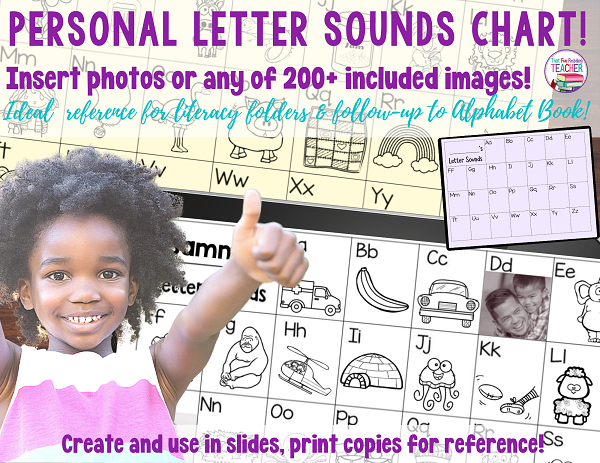When I taught Reading Recovery to grade one students early in the school year, creating a personal alphabet book was one of the first things we did together when we started lessons. We co-created these little books two to three letters at a time, and with some students, it took months.
It became clear over time that the benefits of this thorough practice far outweighed pressure the initial time investment put on many of us in the role. Here’s why:
1. Documentation
As you will see in the next post about creating a personal alphabet book, the starting point is the known, and new pictures are gradually added over time when they are associated with letter sounds. Yes, we are teachers, and we will have our assessment data, but the alphabet book provides evidence of growth over time.
2. Anchoring and motivation
Dr. Clay writes explains that children do not generally learn to identify letters by name or sound in alphabetical order and that identifying a letter by name or sound is equally useful for a child early on, as it is most effective to teach both name and sound together.
When children have one word for each letter that he or she knows for sure makes that letter sound, they use it as an anchor, a concrete example to hold all other words against for comparison.
When they have their own sound alphabet that they have created from the words most meaningful to them, the words that pop into their minds with the initial letter sounds and that association gives them confidence that they know that particular sound.
They are more likely to take the risk and ‘spit’ that sound out when they see an unknown word on a page when they are reading, or put down that first letter when attempting to write a word they have never attempted before.
Looking for a starting point?
Check out this letter / name activity (free)!
About the motivation – every time another little piece is added to the puzzle, confidence is building inside our early literacy students, and the goal of learning their letters and sounds is within reach.
As I update this post, I have just spend the past week making name buses (for the second year) with my kindergarten class. Here is the resource link. The flip book above is free!
3. Reference for reading and writing K-1 (and beyond)
The great thing about building a book like this, is that its contents become long term memory. It can be referenced for reading and writing in the classroom, used for individual or shared reading time and even upgraded later to a personal dictionary. The book can travel through kindergarten with a student into first grade, and even beyond, and keen parents can review it with their children over the summer.
Now that I’m back in the classroom:
When I taught Reading Recovery, I only had four students at a time, and was able to make summary charts of the contents of their personal alphabet books for their classroom teachers and to keep at home (and that was in the days we were cutting up coloring books and flyers for images!)
A number of my students already have associations for most letter sounds, so I have decided that I am going straight to a chart format for them. I will post about, as well, and am planning to update my Personal Alphabet Book product to include this option before the new year!
If you already own it, you will receive an update notice, and can download the update free at any time, regardless of price increase.
Do you have students who are stuck on just one or two letters? Try using small sticky notes to put tabs on the side of those letter pages, or paperclip them for quick reference!
The personal alphabet book is meaningful to each child, because that child constructed it from people and things that are meaningful to them already. The connections are already in place.
The key to the effectiveness of a personalized alphabet book is in its construction. It must be done slowly but with enthusiasm, following the child’s lead, reviewed often and used as reference.
I did create a kit as a time-saver for teachers (pictured below) but it is very easy to create a personal alphabet book with images you collect on your own. Here’s how.
Brand new:

Personal, Editable Alphabet Chart with over 200 images for your Drive! Individualize in you Slides program for each student, then print or send them each their chart! (This has been added as a free update to the original Complete Kit as a part of rolling updates this month, so please check your purchases to see if you already own it!)
Related:
 |
 |









Thank you for this! I never knew why the reading recovery teacher in our school did this when I had an alphabet strip already up on the wall for the students to use.
Thank you for visiting, Samantha. I’m sure that a number of the letters from your alphabet strip ended up in your students’ personal alphabet books. A picture of you may have ended up in there, too! I wonder if an entire class could pull off doing personal alphabet books, perhaps with the help of their reading buddies, two to three letters per visit? Do you think it would be too much to manage? What grade do you teach?
I just spent $200 on supplies for my new classroom and a lot of the things I bought have letters with pictures beside them. I even made sure that they were consistent with each other (all of the ‘a’s were for apple, etc) and I laminated everything. Are you saying we shouldn’t be using any of that?
Hello Lisa, and thank you so much for writing! I’m sure that whatever you bought for your classroom is great. If a child uses something from it in his or her alphabet book, then so be it. He or she will be looking at it on the wall all year. It is a rare child that will have an entire alphabet strip from the wall of a classroom memorized with the exact same associations, unless some serious memory work was done. Have a terrific start to the school year!
Thank you for sharing the benefits of personal alphabet books. When and how do you use it?
Hi Vi! Apologies for taking so long to reply. When I taught Reading Recovery I tried to fit in between one and three letters per day, depending on how much of a grasp the child had on each letter. I started with the easiest, most familiar letters for confidence building, and kept the book beside us for easy reference throughout the sixteen weeks of lessons for easy reference when writing, in particular. I’ve heard of some kindergarten and grade one classes focusing on one to two letters per week to coincide with printing practice / letter formation, or certain word families to build on. The key really is to help capture any links that a child may already have to a letter already, and/or to help them make easy-to-remember connections from important pieces of their lives. With my little students now, JK-gr 3 special education, I try to determine what each child is ready for and go with that. Not as easy in a full class setting. Best wishes to you.